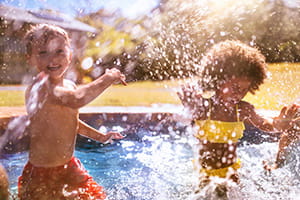Cincinnati Children's Sees Increase in Drowning Deaths in Backyard Pools
Cincinnati Children's Sees Increase in Drowning Deaths in Backyard Pools
Experts remind parents to be extra vigilant about water safety
Tuesday, August 11, 2020
Cincinnati Children’s is reporting nine child deaths this summer due to drowning in backyard swimming pools, up from an average of one to three per year.
“This year we’ve seen a significant increase in the number of drowning deaths and it has our team very concerned,” said Dawne Gardner, injury prevention specialist at Cincinnati Children’s. “Because many community pools are closed due to the COVID-19 pandemic, families are relying more on backyard pools that don’t provide lifeguard supervision. While many people think they would be able to hear if something was wrong with their child, drowning is in fact often silent and very quick.”
Drowning is the number one cause of death for children ages 1-4 years old from unintentional injury nationwide, with nearly 500 deaths in 2017 and close to 9,000 emergency room visits from drownings. Teens are also at risk of drowning as they may over-estimate their swimming ability, be more likely to combine swimming with alcohol use, or swim in areas without supervision.
Here are important reminders to make sure children stay safe and healthy:
- Never leave children alone, or in the care of other children, while in or near bathtubs, pools, spas, or open water
- Empty wading pools and buckets when not in supervised use and turn them upside down so they don’t collect water
- Install fences around home pools
- Assign a water watcher – an adult paying constant attention to children in water
- Put down cell phone
- Avoid other activities
- Supervise even if there are lifeguards
- Switch off with others for breaks
- An adult should be in the water, within arms’ reach, of any child who cannot swim independently
- Speak to teenage children about risks of drowning
- Teach children how to swim – even for children as young as 1, swim lessons may be beneficial
- Know what to do in a drowning emergency – learning basic water rescue skills and CPR may help save a child’s life
Learn more about water safety and drowning prevention on our blog.
Contact Information
Shannon Kettler
shannon.kettler@cchmc.org




